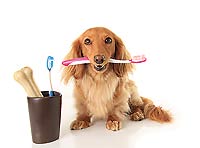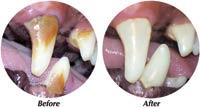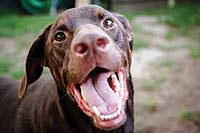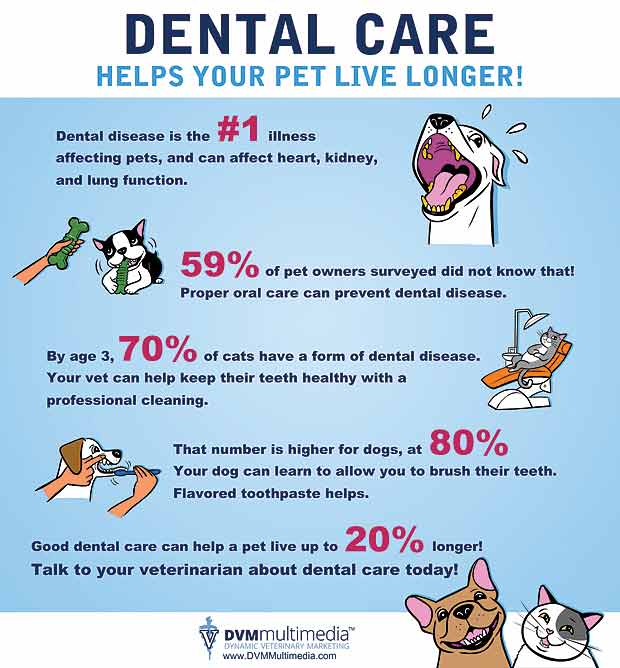Nearly 80 percent of dogs and 70 percent of cats over the age of 3 have oral disease and most often, periodontal (gum) disease. In addition, the risk for periodontal disease increases 20 percent each year of a pet’s life after the age of 3 so older pets are guaranteed to have oral problems.
 Gum disease is inflammation of some or all of a tooth’s deep supporting structures. The condition usually starts with inflammation of a single tooth. Left untreated, the disease progresses to an irreversible stage marked by significant amounts of calculus below the gum line, severe inflammation, gum recession, loose and missing teeth, pus and bleeding from the gums, and significant bone loss. Gum disease is inflammation of some or all of a tooth’s deep supporting structures. The condition usually starts with inflammation of a single tooth. Left untreated, the disease progresses to an irreversible stage marked by significant amounts of calculus below the gum line, severe inflammation, gum recession, loose and missing teeth, pus and bleeding from the gums, and significant bone loss.
Bits of food and accompanying bacteria form a layer of plaque on your dog’s or cat’s teeth and gums. If the plaque isn’t removed, it will soon harden to tartar. A buildup of tartar irritates the gums, causing inflammation. This inflammation, called gingivitis, causes your pet’s gums to change from a healthy pink color to angry red.
If tartar remains on the teeth, it will eventually build up under the gums, causing them to pull away from the teeth. How quickly this process develops depends on a number of factors, including your pet’s age, overall health, diet, breed, genetics, and dental care.
Signs that your cat or dog has gum disease include bad breath, drooling, difficulty chewing, mouth sensitivity, pawing at the mouth, inflamed or bleeding gums, tooth loss, loss of appetite, stomach or other digestive problems, irritable or depressed mood or other behavior changes.
 Oral disease is directly related to heart problems. The culprit is bacteria in the mouth that enters the bloodstream. Oral mucosa is rich with blood vessels that hasten the speed at which bacteria can enter your dog’s bloodstream and travel throughout the body. If your dog has periodontal disease, the surface of the gums is weakened and compromised. The breakdown of gum tissue is the door through which mouth bacteria enters the bloodstream and causes problems with the heart. Oral disease is directly related to heart problems. The culprit is bacteria in the mouth that enters the bloodstream. Oral mucosa is rich with blood vessels that hasten the speed at which bacteria can enter your dog’s bloodstream and travel throughout the body. If your dog has periodontal disease, the surface of the gums is weakened and compromised. The breakdown of gum tissue is the door through which mouth bacteria enters the bloodstream and causes problems with the heart.
In cats there is also tooth reabsorption, which is the gradual progressive destruction of a tooth or teeth caused by cells called odontoclasts. This is a painful condition, but many cats show no obvious signs of pain unless a lesion is touched. Sometimes a kitty with the condition will drool, have bleeding from the mouth, or difficulty eating. There might also be vomiting of unchewed food, behavior changes and bad breath. But it is most often up to an observant pet owner or a veterinarian to diagnose tooth resorption in a kitty.
Feline stomatitis is another extremely painful chronic oral disease in cats. The condition is thought to be autoimmune in nature. In cats with the disease, the immune system overreacts to dental plaque, which triggers an often overwhelming inflammatory response in the tissues of the mouth, throat and even underlying bone.
The risk of painful mouth conditions in particular, gum disease, tooth resorption and oral cancer is dramatically increased for older dogs and cats. This means that for your senior or geriatric pet, proper dental care is critically important.
Daily homecare and as-needed professional cleanings by your veterinarian are the best way to keep your pet’s mouth healthy and disease-free. They are also important for pets with chronic conditions such as diabetes, heart disease and kidney failure. If your pet is highly resistant to having her teeth brushed, there are products available that when applied to the teeth go to work to break down plaque and tartar without brushing.
 It helps to feed a species appropriate, preferably raw diet. Giving your dog or cat the food her body was designed to eat sets the stage for vibrant good health. When your pet gnaws on raw meat, in particular, it acts as a kind of natural toothbrush. This is especially important for kitties, since they don’t enjoy chew bones like their canine counterparts do. Raw fed animals have substantially less dental disease than their dry fed counterparts, but they can still develop problems in their mouth. Unfortunately, feeding great food alone is not enough to prevent dental disease for the life of your pet. It helps to feed a species appropriate, preferably raw diet. Giving your dog or cat the food her body was designed to eat sets the stage for vibrant good health. When your pet gnaws on raw meat, in particular, it acts as a kind of natural toothbrush. This is especially important for kitties, since they don’t enjoy chew bones like their canine counterparts do. Raw fed animals have substantially less dental disease than their dry fed counterparts, but they can still develop problems in their mouth. Unfortunately, feeding great food alone is not enough to prevent dental disease for the life of your pet.
Perform routine mouth inspections. Your pet should allow you to open his mouth, look inside, and feel around for loose teeth or unusual lumps or bumps on the tongue, under the tongue, along the gum line and on the roof of his mouth. After you do this a few times, you’ll become sensitive to any changes that might occur from one inspection to the next. You should also make note of any differences in the smell of your pet’s breath that aren’t diet-related. This is easy way to tell if something is wrong and further inspection is needed.
Arrange for regular oral exams performed by your veterinarian. He or she will alert you to any existing or potential problems in your pet’s mouth, and recommend professional teeth cleaning under anesthesia, if necessary. Obviously, preventing professional intervention is the goal, so be proactive in caring for your pet’s mouth and you can expect more quality years out of their life. Remember to live better with your pets!
 |